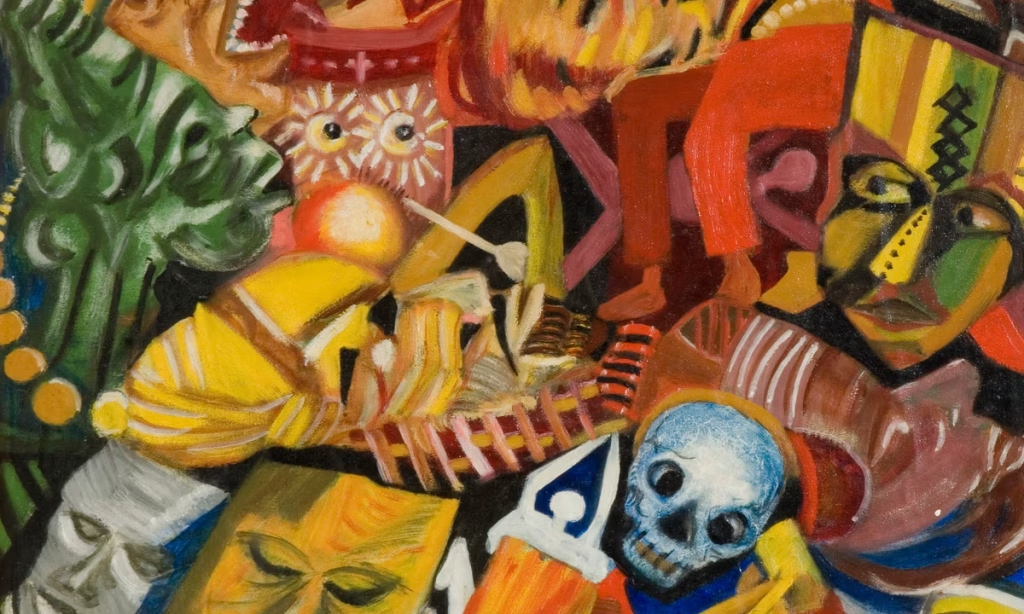When in 2018 Ben Enwonwu’s 1974 portrait of the Ife princess Adetutu Ademiluyi, Tutu, sold at Bonham’s for £1.2m (four times its upper estimate), the author Ben Okri noted that “modern African artists are entirely absent from the story of art”. It was an oversight, he wrote, that urgently needed rectification.
Okri was not being alarmist. Enwonwu’s previous auction record of £360,000 had been set five years earlier, in 2013, when a series of seven large sculptures commissioned for the Daily Mirror’s London headquarters in 1960 had inexplicably surfaced in an East London garage under a pile of rubbish. The news at the time had mostly focused on whether the gangster Kray twins had been responsible for the sculptures’ disappearance. Few seemed to dwell on the extraordinary neglect from which the illustrious Nigerian master, who had sculpted the Queen and awarded an MBE, appeared to have suffered after his death.
Tate Modern’s Nigerian Modernism show is precisely the art historical redress that Okri called for. Where the average Tate survey counts 200 works, the curators Osei Bonsu and Bilal Akkouche have assembled 300. It is a tally commensurate with the outsized task at hand: to delineate the art this vast country produced throughout the better part of the 20th century.
Typically, Bonsu says, “when people think about the development of Modern art in Nigeria, they think about it as a history of colonial encounters, which are mostly predicated on this idea of Nigerian art being somehow behind the times or out of sync with the development of Modernism elsewhere in the world”. Such a flattening, Eurocentric take on Modernism’s emergence fails to account for the sheer variety of contributing factors that led the 59 artists included here to play around with form and deconstruct the figure.
Ben Enwonwu’s 1962 work The Dancer (Agbogho Mmuo—Maiden Spirit Mask) © Ben Enwonwu Foundation; courtesy of Ben Uri Gallery & Museum
Challenging colonial prejudice
The pioneering painter Aina Onabolu was born in 1882 in the Ijebu Kingdom—before it was annexed by the British and its treasures looted—and became the first African student to go to art school in England. He mastered Western easel painting and used portraiture and realism to depict modern African life and challenge colonial prejudice—his 1920 text, A Short Discourse of Art, is a call to Nigerian painterly excellence: “Youngmen, let us wake up to duty; on us depends the future of Nigeria.”
See, too, Uche Okeke, a founding member of the Zaria Art Society in the 1950s, whose revolutionary philosophy of natural synthesis was based, Bonsu says, “on the notion that artists could borrow freely from different artistic cultures and influences”. Though Christian, Okeke rooted his geometric leanings in both Islamic aesthetics and the traditional uli mural painting his mother did. “Young artists in a new nation, that is what we are!” Okeke wrote in his 1960 manifesto, the year of Nigerian independence. “We must grow with the new Nigeria and work to satisfy her traditional love for art or perish with our colonial past.”
Throughout the show, artists are, Bonsu says, “using techniques that may be somewhat familiar to a European Modernist culture, but are radically Nigerian in what they’re trying to express and what they’re trying to convey.” Anticolonial perspectives played a significant role in their development, to be sure, but so too did the idealism of early nation-building and the reckoning with civil war. They grappled with cultural nationalism and Pan-African and Négritude thinking. They critically appraised both the traditions they grew up with and the art history they were taught at school—what Bonsu terms “a dual inheritance”. He adds: “I think it’s important to note, maybe as a point of irony, that there were Black artists contemplating both Blackness and history painting before Kerry James Marshall.”
The show is not archival but single-mindedly focused on art. That said, the challenges the curators faced accessing archival materials, not to mention the works of art themselves, says a lot about why it is of such critical importance. Many of the pieces in the show are from private collections and have never been seen in an institutional context. Others are held in regional institutions or universities, in ethnographic or encyclopaedic collections, but not art museums.
Research has further taken the curators to, for instance, the Unilever archive, which, due to the company’s connection to Nigeria during the colonial period, includes invaluable records. Bonsu emphasises however that this is not a show about absence, “the sense of loss that’s often associated with the post-colonial experience”. It is a celebration of “what is there to be seen”, he says.
• Nigerian Modernism, Tate Modern, until 10 May 2026
